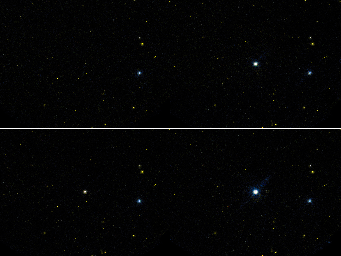This movie taken by NASA'S Galaxy Evolution Explorer shows one of the largest flares, or star eruptions, ever recorded at ultraviolet wavelengths. The star, called GJ 3685A, just happened to be in the Galaxy Evolution Explorer's field of view while the telescope was busy observing galaxies. As the movie demonstrates, the seemingly serene star suddenly exploded once, then even more intensely a second time, pouring out in total about one million times more energy than a typical flare from our Sun. The second blast of light constituted an increase in brightness by a factor of at least 10,000.
Flares are huge explosions of energy stemming from a single location on a star's surface. They are caused by the brief destruction of a star's magnetic fields. Many types of stars experience them, though old, small, rapidly rotating "red dwarfs" like GJ 3685A tend to flare more frequently and dramatically. These stars, called flare stars, can experience powerful eruptions as often as every few hours. Younger stars, in general, also erupt more often. One of the reasons astronomers study flare stars is to gain a better picture and history of flare events taking place on the Sun.
A preliminary analysis of the GJ 3685A flare shows that the mechanisms underlying stellar eruptions may be more complex than previously believed. Evidence for the two most popular flare theories was found.
Though this movie has been sped up (the actual flare lasted about 20 minutes), time-resolved data exist for each one-hundredth of a second. These observations were taken at 2 p.m. Pacific time, April 24, 2004. In the still image, the time sequence starts in the upper left panel, continues in the upper right, then moves to the lower left and ends in the lower right.
The circular and linear features that appear below and to the right of GJ 3685A during the flare event are detector artifacts caused by the extreme brightness of the flare.

 Planetary Data System
Planetary Data System












